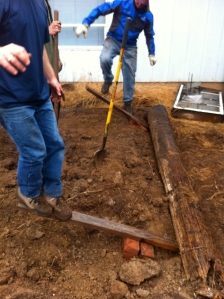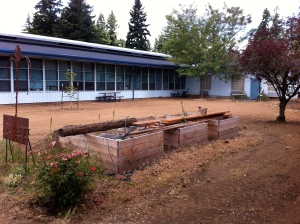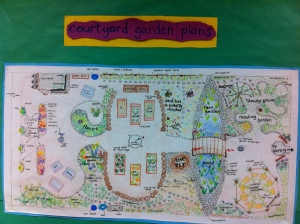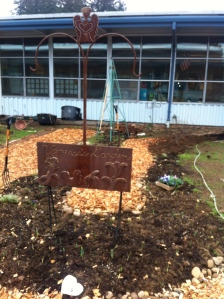Gilbert Park Elementary School’s Courtyard Garden Project began in the fall of 2011, when a classroom teacher and our school’s SUN coordinator decided to work together to transform the school’s central courtyard into a space that was more user-friendly to students and teachers, environmentally focused in its makeup, and educationally useful as a school resource.
As pictured at left, the central courtyard (the green patch surrounded by gray rooftops) for many years was simply grass, shrubs, some picnic tables, and a smattering of diseased plum trees and invasive butterfly bushes. At one point a teacher installed a few raised beds and flowers as a memorial to a student who died tragically before her time (“Vanessa’s Garden”). He worked with his students in this space successfully for many years, growing a few fruits and vegetables and studying the stones and soil in which they worked. But when he retired several years ago, the beds went to weeds with disuse. There was clearly a lot of potential within the space, but is the case at many schools, teachers and families had plenty else to focus on day-to-day before giving the space a makeover.
And so, our two garden champions disbursed surveys to the school community, hired a landscape architect, submitted grant proposals and were awarded funding. They discovered that teachers really liked the idea of having a space to work safely with their students outdoors, whether for academic lessons or reflective activities such as buddy time and journals. They looked forward to having hands-on resources for teaching life cycles, ecosystems, habitats, science and inquiry. Some saw opportunity to bring more art into the school environment, or for composting waste from the cafeteria. One anonymous responder suggested the whole courtyard be covered and the majority of it paved, so that it might actually be used year-round. All seemed concerned about long-term maintenance, about how much time they would realistically be able to spend maintaining (let alone using) the space consistently.
And this speaks to a unique aspect of the development of our school garden, something that makes it somewhat atypical among other projects of this kind. The fact is, the vast majority of school gardens are initiated by some sort of “green team,” made up of members of the school community who often work tirelessly from a place of personal interest and urgency to ensure that sustainability and wellness are included in the academic day. Typically, success stories of school gardens emerge from schools with robust PTA funds and parents with lots of time and resources to spare. With nearly 70% of students here qualifying for free or reduced lunch and more than 25% learning English as a second language, many GP families are (quite reasonably) more concerned with making ends meet than building the school a garden; we couldn’t expect them to take the lead on this one.
Fortunately, this is what the SUN program is all about; capitalizing and leveraging the resources intrinsic to a neighborhood community so that the success of a school and its students is not entirely dependent on the means of families, teachers, and staff.
And so, when the grants came through in the summer of 2012, a contractor was hired to remove the sod and shrubs, and I was hired as Garden Education Coordinator for the school. During our month-long summer SUN session, I worked with students to tidy up our two smaller native habitat and butterfly gardens, as this went on in the courtyard:
When we returned to school in September, the courtyard had been transformed into a blank slate:
and our vision for the space came into form:
Much work has gone into the courtyard since. We held a few rainy work parties through the fall, during which we removed the creosote-laden telephone poles that had formed the borders of the original garden: 

Fourth- and fifth-grade “garden helpers” have worked tirelessly during their recesses to spread cardboard and wood chips, dig out a swale for our rain garden, establish the Bird, Bee and Butterfly Meadow, and to gently expand and slightly relocate Vanessa’s Garden.
In a few short months, despite rain and snow, freezing temperatures and topsoil littered with HUNDREDS of rocks deposited over 10,000 years ago with the Missoula Floods, students have accomplished a great deal of work:
So far, we’ve got beds planted full of bulbs that are just itching to jump out of the ground. We’ve got raised beds just waiting in position for the next delivery of soil, wood chips just waiting for a bit more cardboard to go underneath, to block the weeds. We’ve got dozens of native plants ready and waiting for the soil to defrost, and two more orders on deck. Students are thrilled and eager to participate in the process, and take great pride in the knowledge that their work will be enjoyed by students at this school forever after.
There is still plenty of work to be done, and plenty of bad weather to be waited out. But please, keep an eye on us! We’re many months into our project at this point, but the growing season is just beginning!








